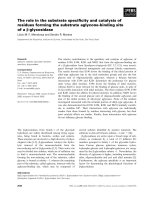Tài liệu Báo cáo khoa học: "The Role Of Focussing in Interpretation of Pronouns " pdf
Bạn đang xem bản rút gọn của tài liệu. Xem và tải ngay bản đầy đủ của tài liệu tại đây (103.85 KB, 2 trang )
The Role
Of
Focussing in Interpretation of Pronouns
Candace
L.
Sidner
Artificial Intelligence Laboratory
Massachusetts
Institute
of Technology
Cambridge, MA 02139
;rod
Bolt, Beranek and Newman, Inc.
50 Moulton Street
Cambridge" MA 02138
In this p;,per I [ discuss the formal relationship between
the process of focussing and interpret;ition of pronominal
anaphora. The discussion of focussing extends the work of
Grosz [1977]. Foct,ssing is defined algorithmical]y as a process
which chooses a focus of attention in a discourse and moves it
around as the speaker's focus ch'mges. The paper shows how to
use the focussing algorithm by ;m extended example given below.
DI-I Alfred a,ld Zohar liked to play baseball.
2 They played it everyday after school before
dinner.
3 After their game, the two usually went for ice
cream cones.
4
They tasted really good.
5 Alfred always had the vanilla super scooper,
6 while Zohar tried the flavor of the day cone.
7 After the cones had been eaten,
8 the boys went home to study.
In this example, the discourse focusses initially on baseball. The
focus moves in DI-3 to the ice cream cone. Using this example,
I show how the formal algorithm computes focus and determines
how the focus moves according to the signals which the speaker
uses in discourse to indicate the movement.
Given a process notion of focus, the paper reviews the
difficulties with previous approaches (Rieger [1974], Charniak
[1972], Winograd [1971], Hobbs [1975] and Lockman [1978]).
Briefly, the first four authors all point out the need for
inferencing as part of anaphora disambiguation, but each of
their schemes for inferencing suffer from the need for control
which will reduce the combinatorial search or which will insure
only one search path is taken. In addition, Winograd and
Lockman are aware of pronopn phenomena which cannot be
treated strictly by inference, as shown below.
D2-1 I haven't seen Jeff for several days.
2 Carl thinks h e's studying for his exams.
3
Oscar says
hj
is sick,
4 but I think he went to the Cape with Linda.
1. This report describes research done at the Artificial
Intelligence Laboratory of the Massachusetts Institute of
Technology.
Support for the laboratory's artificial intelligence
research is provided in part by the Advanced Research Projects
Agency of the Department of Defense under the Office of
Naval Research under Contract Number N00014-73-C4)643.
However, their approaches are either simple heuristics which
offer no unified treatment (Winograd) or require the
computation of a structure which must assume the pronouns
have previously been resolved (Lockman).
In order to state formal rules for pronoun
interpretation, the concept of antecedence is defined
computationally as a relationship among elements represented in
a database. Using this framework, the paper supports two
claims by means of rules for antecedence.
I.
The
focus provides a source of
antecedence in rules for interpreting
pronominal anaphora.
2. Focussing provides a control for the
inferencing necessary for some kinds of
anaphora.
The rules
confirming
restrictions
The use of
D3 below.
D3-I
2
for pronominal anaphora rely on three sources of
information: syntactic criteria, semantic selectional
and consistency checks from inferencing procedures.
these rules are presented for examples D2 above and
Whitimore isn't such a good thief.
The man whose watch he stole called the
police.
3 They catzght him.
These examples show how
to
use the three sources of
information to support or reject a predicted antecedence. In
particular, inferencing is controlled by checking for consistency
on a predicted choice rather than by search ~lsing general
inference.
The paper also indicates what additional requirements
are needed for a full treatment of pronominal anphora. These
include use of a representation such as that of Webber [197g];
linguistic rules such as the disjoint reference rules of Lasnik
[[976] and Reinhart [[976] as well as rules of anapbora in
logical form given by Cbomsky [1976]; and presence of actor
loci such as they in D3. The nature of these requirements is
discussed, while the computational inclusion of them is found in
$idner [ 1979].
"77
1.
References
Charniak, E. [1972] Toward a Mode/ Of Children's Slot 7
Comprehension. M.I.T.A.I. Lab TR-266.
Chmnsky, N. [1976] Conditions on Rules o[ Grammar. Linguistic
Aqi,!ys_~is Voh,ne 2, p. 303-351.
Orosz, Barb;ira [1977] The Representation and Use
o[ Focus
in
Dialogue Understanding. St~,nford Research Institute
Technical Note 151, Menlo Park, California
Hobbs, Jerry R. [1976]
Pronoun Resolution.
Research Report
~76-I,
City College, City University of New York, New
York.
Lasnik, Howard [1976]
Remarks on Co.re[erenc¢.
Linluistic
An;~'sis, Volume 2, Number 1.
Lockman, Abe D. [1978] Conlextual Re[erenee R•olution in
Natural Language Processing. Dept. of Computer Science
TR-70, Rutgers University, New Brunswick, N.J.
Reinhart, T;mya [1976] The Syntactic Domain of Anaphora.
unpublished Ph.D. dissertation, Department of Foreign
Literature and LinBuistics, M.I.T.
Rieger, Charles J. [1974] Conceptual Memory: A Theory and
Compufer Program for Processing Ihe Meaning Content of
Natural Language Utterances. Stanford Artificial Intelligence
Lab Memo AIM-233.
Sidner, Candace L. [1979] To,'ards a Computational Thmr 7 of
Definite Anaphora Comprehension in £nglish Discour~.
unpublished Ph.D. disseration, Electrical Engineering and
Computer Science, M.I.T.
Webber,
Bonnie
Lynn [1978] A
Formal Approc~k to Discourse
Anaphora. Technical Report 3761, Bolt, Beranek and
Newman, Cambridge MA.
Winograd, Terry [1971] Procedures as a Repraentatian for Data
in a Computer Program for Understanding Natural
Language. M.I.T. dissertation.
78








![Tài liệu Báo cáo khoa học: The stereochemistry of benzo[a]pyrene-2¢-deoxyguanosine adducts affects DNA methylation by SssI and HhaI DNA methyltransferases pptx](https://media.store123doc.com/images/document/14/br/gc/medium_Y97X8XlBli.jpg)
